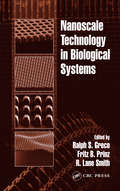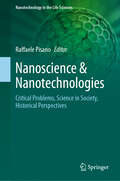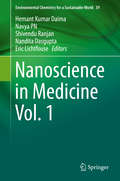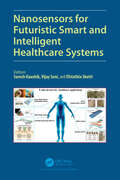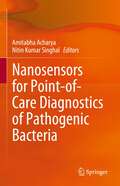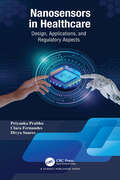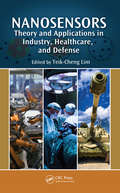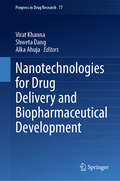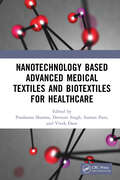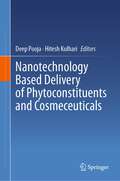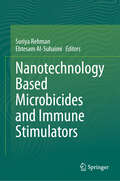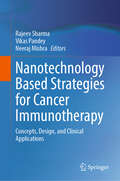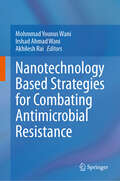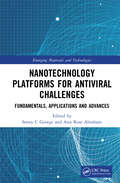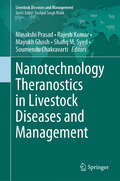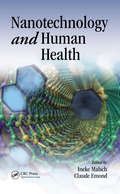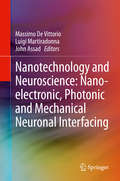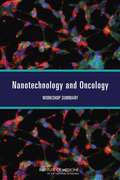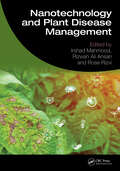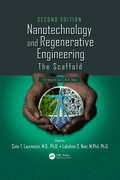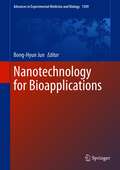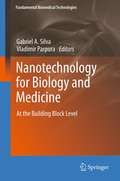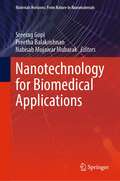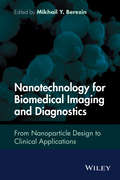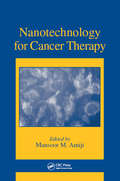- Table View
- List View
Nanoscale Technology in Biological Systems
by Fritz B. Prinz Ralph S. Greco R. Lane SmithNanoscale Technology in Biological Systems reviews recent accomplishments in the field of nanobiology and introduces the application of nanoscale matrices to human biology. It focuses on the applications of nanotechnology fabrication to biomedical devices and discusses new physical methods for cell isolation and manipulation and intracellular commu
Nanoscience & Nanotechnologies: Critical Problems, Science in Society, Historical Perspectives (Nanotechnology in the Life Sciences)
by Raffaele PisanoNanoscience has explored new modelling and new devices in the applied sciences and technologies, in health and life sciences. This includes work on structures, nano-machines, communications, environment and materials science, closing the gap for society toward a sustainable civilization. Feynman's Plenty of Room (1959) opened a new perspective/science in society debate: how can we handle the applications––and––implications of nanoscience? What is the human factor in the 21st century? This volume offers both the state-of-the-art in the field and the corresponding research with discussion of exciting developments in nanoscience technologies, including historical, educational and societal aspects. For the first time, in a unique volume, it brings together cutting-edge chapters in a multi-disciplinary and historical context. It describes the ways it differently accounted for variation in unlike countries and consequently how its results remain, still nowadays, a debated question, as well as due to constraints preventing an extensive exploration of its remarkable historiography. It is written by leading authoritative scholars working in the various respective fields. This book is ideal for scientists, historians, and scholars interested in nanoscience and its historical-societal ramifications.
Nanoscience in Medicine Vol. 1 (Environmental Chemistry for a Sustainable World #39)
by Eric Lichtfouse Shivendu Ranjan Nandita Dasgupta Hemant Kumar Daima Navya PnThis book takes a systematic approach to address the gaps relating to nanomedicine and bring together fragmented knowledge on the advances on nanomaterials and their biomedical applicability. In particular, it demonstrates an exclusive compilation of state of the art research with a focus on fundamental concepts, current trends, limitations, and future directions of nanomedicine.
Nanosensors for Futuristic Smart and Intelligent Healthcare Systems
by Suresh Kaushik, Vijay Soni and Efstathia SkottiThe book, Nanosensors for Futuristic Smart and Intelligent Healthcare Systems, presents a treatise on nanosensors technology including wearables, implantable devices and wireless tools. The recent pandemic (COVID-19) has changed the behaviour of people towards diagnosis of infectious diseases and monitoring remote patient health status in real-time. The main focus of this book is the basic concepts of nanomaterials and sensing paradigms for medical devices based on nanosensor technology. The book will be valuable to researchers, engineers and scientists interested in the field of healthcare for monitoring health status in real-time.
Nanosensors for Point-of-Care Diagnostics of Pathogenic Bacteria
by Amitabha Acharya Nitin Kumar SinghalThis book comprehensively reviews various nanodiagnostic approaches for the detection of bacterial pathogens. The initial chapter of the book discusses receptors present on bacterial cell surfaces that can be targeted for diagnostic applications. The book then presents different fluorescent nanoparticle systems that are used for bacterial detection. Further, it covers surface plasmon resonance (SPR), ELISA, and QCM-based nanosensors to detect pathogenic bacteria. It examines different nanosensors used for the microfluidic-based detection of bacterial pathogens, including microfluidic paper-based analytical devices (μPADs), lateral flow devices, and miniaturized PCR devices. The book also covers the current electrochemical, voltammetric, and amperometric nanosensors-based microorganism recognition approaches. Lastly, the book summarizes the current challenges and the futuristic application of nanosensors to detect bacterial pathogens. This book is an invaluable resource for all medical laboratories and clinical institutions dealing with infectious diseases.
Nanosensors in Healthcare: Design, Applications, and Regulatory Aspects
by Priyanka Prabhu Clara Fernandes Divya SuaresNanosensors enable early diagnosis of various conditions with enhanced selectivity and sensitivity thus facilitating prompt initiation of therapy. This book introduces the readers to the basic concept of a nanosensor; the working of different nanosensors based on electrochemical, optical, magnetic, ultrasound, and hybrid sensing; and their varied applications in the healthcare field. This book highlights the regulatory aspects of nanosensors and the prospects of nanosensors in healthcare. The objective is to give the readers an overview of the possibilities and advances in the field. This book would provide deeper insights into designing nanosensors for precise diagnosis of various diseases.
Nanosensors: Theory and Applications in Industry, Healthcare and Defense
by Teik-Cheng LimNanosensors are rapidly becoming a technology of choice across diverse fields. They offer effective and affordable options for detecting and measuring chemical and physical properties in difficult-to-reach biological and industrial systems operating at the nanoscale. However, with nanosensor development occurring in so many fields, it has become di
Nanotechnologies for Drug Delivery and Biopharmaceutical Development (Progress in Drug Research #77)
by Virat Khanna Shweta Dang Alka AhujaThis book is a comprehensive coverage of the transformative role of nanotechnology in the field of biopharmaceuticals. The book covers the fundamental principles of nanotechnology and systematically explains how nanomaterials are revolutionizing drug delivery systems, formulation techniques, diagnostics, and imaging modalities. Through detailed discussions on lipid-based nanocarriers, polymeric nanoparticles, dendrimers, and nanogels, readers gain insights into the diverse array of nanomaterials and their applications in enhancing drug efficacy, targeting specific tissues, and minimizing adverse effects. Moreover, the book addresses critical aspects such as biocompatibility assessment, regulatory considerations, and ethical implications, underscoring the importance of responsible innovation in the development and commercialization of nano biopharmaceuticals. This book serves as an invaluable resource for researchers and practitioners to navigate the complex landscape of biopharmaceutical development. Through its interdisciplinary approach and forward-thinking perspectives on future trends and challenges, it contributes to shaping the future of healthcare by harnessing the power of nanotechnology to deliver innovative and effective therapeutics. The target audience for this book covers the fields of biopharmaceutical research, development, regulation, and policymaking. This includes scientists, researchers, and engineers seeking a deep understanding of nanotechnology's applications in drug delivery systems, formulation techniques, and diagnostic tools. Additionally, pharmaceutical industry professionals involved in drug development and manufacturing will find valuable insights into innovative nanoscale formulations and regulatory considerations. Overall, this book caters to a multidisciplinary audience seeking to leverage nanotechnologies for advancing biopharmaceutical research, development, and clinical practice.
Nanotechnology Based Advanced Medical Textiles and Biotextiles for Healthcare
by Vivek Dave Prashansa Sharma Devsuni Singh Suman PantThis book provides systematic coverage of research into medical and biotextiles based on nanomaterials as applicable in healthcare. Divided into three sections, it explains manufacturing, properties, types, and recent developments in nanotechnology based medical textiles backed by case studies. It includes a wide range of different clinical applications of biotextiles for healthcare including nanotextile scaffolds, nano-based artificial organs, surgical sutures, enzymatic assisted enhanced biotextiles, tissue engineering or drug delivery system via nanofibers, and so forth.Features: Provides strong and broad overview of medical applications in the field of nano and biotextiles. Highlights different approaches, recent research, and emerging innovations. Covers designing or developing nanomaterials based antiviral surface disinfectants with self-cleaning property. Reviews different applications of nano based medical textiles such as deodorizing or pH control clothing for hygiene maintenance. Includes the real-life applications based descriptive case studies that offer a diverse range of perspectives. This book is aimed at researchers and graduate students in textile technology and engineering, and medical textiles.
Nanotechnology Based Delivery of Phytoconstituents and Cosmeceuticals
by Deep Pooja Hitesh KulhariThis book explores the role of nanotechnology in the delivery of natural phytoconstituents and cosmeceuticals. It presents polymeric nanocarriers, lipid-based nanocarriers, metal/metal oxide nanocarriers, protein nanocarriers, and dendrimers for the delivery of phytoconstituents. Further, it focuses on the usage of phytocompounds in various cosmeceutical products and nano delivery technologies used in the delivery of various cosmeceuticals. Finally, the book reviews the toxicity issues of nanoparticles in the delivery of phytoconstituents and cosmeceuticals and regulatory aspects for clinical applications of nano phytomedicines. This book is helpful for academicians and researchers working in pharmaceutical sciences, nano science, material science, plant science, and cosmetic science.
Nanotechnology Based Microbicides and Immune Stimulators
by Suriya Rehman Ebtesam Al-SuhaimiThis book reviews the use of nano-based drug delivery systems and biomaterials to enhance the immune system against infectious diseases. It focusses on the inbuilt immunoreactive properties of nanomaterials and the advancement in its engineering to modulate the immune system either via immune-stimulation or immunosuppression. The book further discusses the use of nanoparticle-based vaccines to improve vaccine efficacy, immunization strategies, and targeted delivery to achieve desired immune responses at the cellular level against infectious diseases. Perhaps, book focusses on nanoscale diagnostics that offer new approaches for sensitive health monitoring that are potable and can guide the use of nanoscale therapies. This book explores the potential of immunomodulatory nanotechnologies, focusing not only on their benefits, but also on biocompatibility, and toxicity concerns, while highlighting promising innovations in Interferon-based immune therapies and addressing key challenges in achieving safe, scalable nanotech products. The book would encompass broad topics to attract the diverse specialty of physicians, health professionals, students, faculty, and researchers of nanotechnology, nanomedicine, infectious diseases, public health, immunology, bacteriology, virology, pathology, biotechnology, toxicology, and biomedical technology.
Nanotechnology Based Strategies for Cancer Immunotherapy: Concepts, Design, and Clinical Applications
by Neeraj Mishra Vikas Pandey Rajeev SharmaThis book will give an up-to-date and thorough exposition of the state of the art of concepts, design, and recent advances in nanobiotechnology-based strategies for cancer Immunotherapy, and their current and clinical status. Nanobiotechnology-based Targeted therapies and Immunotherapy have been added to the effective oncologic treatment and have become increasingly popular in oncology. It is intended to enable the researchers to prepare a variety of Nanobiotechnology-based strategies, investigate their properties, and discover their uses and applications in cancer immunotherapy. The novelty of the approach is to address an existing need to understand exhaustively the potential of the nanotechnology-based approaches, including targeted and smartly designed therapies, that deliver loaded immunoreactive (s) into the body at predefined sites. The book will also discuss the patents related to cancer immunotherapy. Because of the versatility and wide range of properties, nanobiotechnology-based systems are extensively used in cancer immunotherapy. The task of obtaining a versatile candidate in immune component(s) delivery seems to be intricated, as it has to surpass several vigorous clinical barriers. As a result, many scientists rely on nanobiotechnology-based approaches, which have already been approved and well-established. Over the years, extensive research has been undertaken on the delivery of immunoreactive(s) using nanotechnology-based delivery systems. With advancements in nanobiotechnology, more needs are realized to develop nanoengineered/smart delivery systems with even more convoluted properties. Currently, research is mainly focused on nanoengineered systems, which can perform one or more of the desired functions. The proposed book summarizes the basic principles and research supporting cancer immunotherapy clinical translation contains nanobiotechnology-based treatment strategies for all immunotherapy classes and agents, including cell-based therapies, monoclonal antibodies, cytokine therapies, checkpoint inhibitors, oncolytic viruses, adjuvant approaches, treatment combinations Includes information on all FDA-approved immunotherapies, for individual cancer types, including melanoma and other skin cancers, lung cancers, gastrointestinal cancers, hematologic cancers, genitourinary cancers, head and neck cancers, sarcomas, brain cancers, and breast cancer etc. Also explains the regulatory aspects behind the development and approval of immunotherapy drugs.
Nanotechnology Based Strategies for Combating Antimicrobial Resistance
by Mohmmad Younus Wani Irshad Ahmad Wani Akhilesh RaiThis book provides a comprehensive overview of recent advances in nanotechnology as an alternative strategy for addressing antimicrobial resistance (AMR). Examining nanotechnology-based methods such as nanoencapsulation, drug delivery, and conjugation, the text highlights their successful application in treating microbial infections with reduced resistance and off-target toxicity. The introductory section outlines AMR and explores diverse mechanisms of microbial resistance, emphasizing the potential of nanotechnology to surmount these challenges. Subsequent chapters investigate the role of specific nanomaterials—metal nanoparticles, metal oxide nanoparticles, functionalized quantum dots, magnetic nanoparticles, bimetallic nanoparticles, nanocomposites, carbon nanomaterials, and polymer-based nanomaterials—in overcoming antimicrobial resistance. Several chapters focus on the efficacy of nanoemulsions as an antimicrobial delivery method, underscoring their inherent antimicrobial properties, capacity to enhance drug solubility, stability, bioavailability, and targeting potential at the organ and cellular levels. The concluding section provides a detailed review of liposomes, dendrimers-based nanoparticles, and micelles as drug delivery vehicles in the context of combating pathogens resistant to antimicrobials.
Nanotechnology Platforms for Antiviral Challenges: Fundamentals, Applications and Advances (Emerging Materials and Technologies)
by Soney C George and Ann Rose AbrahamNanotechnology provides an innovative platform for drug delivery and antiviral actions. This book discusses the utilization of nano-based formulations for the control of viral agents. The antiviral potential of green synthesized silver, chitosan nanoparticles encapsulating curcumin, photoinduced antiviral carbon nanohorns, and the role of carbon-based materials like fullerenes, and carbon nanotubes in the repression of viral antigens are explained. The book also covers nanomaterial-based solutions for SARS-CoV-2 and other viral infections. Features: Explains theory and practical applications of nanomaterials as antiviral agents. Reviews upscaling of nanomaterials from laboratory to fabrication stage. Illustrates nanocurcumin, silver nanoparticles, and carbon nanoparticles for biomedical applications. Highlights role of nanotechnology in effectively combating viral infections and pandemics. Includes case studies of specific pharma companies. This book is aimed at researchers, graduate students in materials science, microbiology and virology, and pharmaceutical sciences.
Nanotechnology Theranostics in Livestock Diseases and Management (Livestock Diseases and Management)
by Rajesh Kumar Minakshi Prasad Mayukh Ghosh Shafiq M. Syed Soumendu ChakravartiThis book reviews various applications of nanotechnology in the prophylactic, diagnostic, and therapeutic management of livestock diseases. The initial section discusses the strategies for the synthesis of nanomaterials and characterization of different nanomaterials. The subsequent chapters explore the role of nanoparticles in the diagnosis of diseases caused by pathogenic microorganisms, including bacteria, viruses, protozoans, and fungi. The book also examines the nano sensors that are used for point-of-care diagnosis of various livestock diseases. Additionally, it highlights nanoparticles-based vaccines and vaccine delivery systems to combat bacterial livestock diseases. Lastly, the book entails the strategies for developing nanotherapeutics for the treatment of bacterial, viral, fungal diseases, metabolic disorders, and cancer in livestock animals. The content of this book is useful for researchers and practitioners interested in understanding the applications of nanotechnology in diagnostics and therapeutics of livestock diseases.
Nanotechnology and Human Health
by Paul C. H. LiAddressing medium- and long-term expectations for human health, this book reviews current scientific and technical developments in nanotechnology for biomedical, agrofood, and environmental applications. This collection of perspectives on the ethical, legal, and societal implications of bionanotechnology provides unique insight into contemporary te
Nanotechnology and Neuroscience: Nano-electronic, Photonic and Mechanical Neuronal Interfacing
by Massimo De Vittorio Luigi Martiradonna John AssadThis book describes the use of modern micro- and nanofabrication technologies to develop improved tools for stimulating and recording electrical activity in neuronal networks. It provides an overview of the different ways in which the "nano-world" can be beneficial for neuroscientists, including improvement of mechanical adhesion of cells on electrodes, tight-sealed extracellular recordings or intracellular approaches with strongly reduced invasiveness and tools for localized electrical or optical stimulation in optogenetics experiments. Specific discussion of fabrication strategies is included, to provide a comprehensive guide to develop micro and nanostructured tools for biological applications. A perspective on integrating these devices with state-of-the-art technologies for large-scale in vitro and in vivo experiments completes the picture of neuronal interfacing with micro- and nanostructures.
Nanotechnology and Oncology
by Margie PatlakOne way scientists are working to overcome challenges in cancer treatment and improve cancer care is through nanotechnology. Nanotechnology, engineered materials that make use of the unique physical properties, presents a new array of medical prospects that will revolutionize cancer prevention, diagnosis, and treatment practices. Giving new hope to patients, practitioners, and researchers alike, nanotechnology has the potential to translate recent discoveries in cancer biology into clinical advances in oncology. While public investments in nanotechnology for cancer continue to increase, medical products based on nanotechnology are already on the market. The National Cancer Policy forum held a workshop July 12-13, 2010, to explore challenges in the use of nanotechnology in oncology. Nanotechnology and Oncology evaluates the ongoing discussion on the role of nanotechnology in cancer as it relates to risk management, treatment, and regulatory policy. Assessments on nanomedicine and the physical properties of nanomaterials were presented during the workshop, along with an appraisal of the current status of research and development efforts.
Nanotechnology and Plant Disease Management
by Rizwan Ali Ansari Irshad Mahmood Rose RizviNanotechnology and Plant Disease Management explores the intersection of nanotechnology and agriculture. This book serves as a comprehensive exploration of the current state and future potential of nanoparticles in revolutionizing plant disease management within the realm of agriculture. This book elucidates the synthesis, characterization and judicious application of nanoparticles, providing a clear and accessible explanation of what nanomaterials are, how they are characterized, and their pivotal role in reshaping the plant disease management systems. It scrutinizes innovative strategies that influence the unique properties of nanoparticles to identify and monitor the presence of pathogens at early stages. The book also examines the limitations inherent in the use of nanomaterials for disease management in plants by critically evaluating both sides of the spectrum. This aims to provide a candid overview of the hurdles that must be overcome to unlock the full benefits of nanotechnology in this field. By pinpointing and understanding these obstacles, the current work aims to pave the way for effective strategies and solutions, ensuring the responsible and optimized application of nanomaterials for enhanced plant disease management. This in-depth examination serves as a cornerstone, providing readers with a profound understanding of the intricate processes involved in synthesis, characterization and utilizing nanomaterials for disease control. Nanotechnology and Plant Disease Management is a testament to the transformative potential of nanotechnology in agriculture. The authors invite readers to embark on this enlightening journey, exploring the intricate world of nanomaterials and their application in safeguarding the health and vitality of plants.
Nanotechnology and Regenerative Engineering: The Scaffold, Second Edition
by Cato T. Laurencin M. Phil. Lakshmi S. NairNanotechnology and regenerative engineering have emerged to the forefront as the most versatile and innovative technologies to foster novel therapeutic techniques and strategies of the twenty-first century. The first edition of Nanotechnology and Tissue Engineering: The Scaffold was the first comprehensive source to explain the developments in nano
Nanotechnology for Bioapplications (Advances in Experimental Medicine and Biology #1309)
by Bong-Hyun JunThis book documents the tremendous progress in the use of nanotechnology for a range of bioapplications with the aim of providing students, researchers, technicians, and other professionals with an up-to-date overview of the field. After a general introduction to the surface modifications of nanoparticles required for different biological applications, and to the properties of the modified nanoparticles, a series of chapters describe the state of the art in respect of different types of nanoparticle, including silica nanoparticles, fluorescent nanomaterials, metal nanoparticles, magnetic nanoparticles, carbon-based nanostructures, and other novel nanomaterials. Detailed information is supplied on methods of preparation, chemical and physical properties, and current and potential applications. The closing chapters discuss lithography methods for the top-down approach to nanoparticle synthesis and the use of spectroscopic studies as a tool for the characterization of each nanoparticle. Future prospects and challenges for the development of further nanomaterials with bioapplications are also covered.
Nanotechnology for Biology and Medicine
by Gabriel A. Silva Vladimir ParpuraThis text book will bring together a mix of both internationally known and established senior scientists along side up and coming (but already accomplished) junior scientists that have varying expertise in fundamental and applied nanotechnology to biology and medicine.
Nanotechnology for Biomedical Applications (Materials Horizons: From Nature to Nanomaterials)
by Nabisab Mujawar Mubarak Preetha Balakrishnan Sreerag GopiThis book provides an overview of the use of nanoparticles, carbon-nanotubes, liposomes, and nanopatterned flat surfaces for specific biomedical applications. This book explains the chemical and physical properties of the surface of these materials that allow their use in diagnosis, biosensing and bioimaging devices, drug delivery systems, and bone substitute implants. The toxicology of these particles is also discussed in the light of a new field referred to as nanotoxicology in this book. This book will be useful for engineers, researchers and industry professionals primarily in the fields of polymer science and engineering, materials science, surface science, nanocatalysis, biotechnology and biomedicine.
Nanotechnology for Biomedical Imaging and Diagnostics: From Nanoparticle Design to Clinical Applications
by Mikhail Y. BerezinNanotechnology for Biomedical Imaging and Diagnostics: From Nanoparticle Design to Clinical Applications reflects upon the increasing role of nanomaterials in biological and medical imaging, presenting a thorough description of current research as well as future directions. With contributions from experts in nanotechnology and imaging from academia, industry, and healthcare, this book provides a comprehensive coverage of the field, ranging from the architectural design of nanomaterials to their broad imaging applications in medicine. Grouped into three sections, the book: Elucidates all major aspects of nanotechnology and bioimaging Provides comprehensive coverage of the field, ranging from the architectural design of nanomaterials to their broad imaging applications in medicine Written by well-recognized experts in academia, industry, and healthcare, will be an excellence source of reference With a multidisciplinary approach and a balance of research and diagnostic topics, this book will appeal to students, scientiests, and healthcare professionals alike
Nanotechnology for Cancer Therapy
by Mansoor M. AmijiWhile simultaneous breakthroughs occurring in molecular biology and nanoscience/technology will ultimately revolutionize all of medicine, it is with our efforts to prevent, diagnose, and treat cancer that many of the most dramatic advances will occur. In support of this potential, the U.S. National Cancer Institute (NCI) established the Alliance fo
